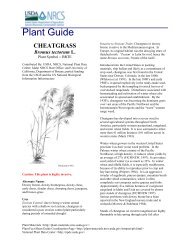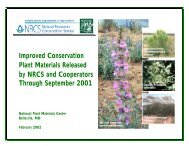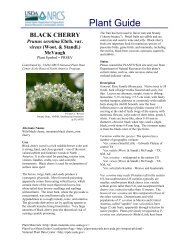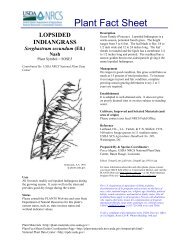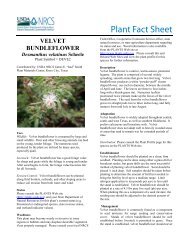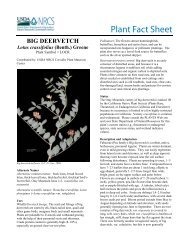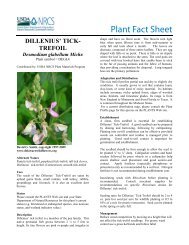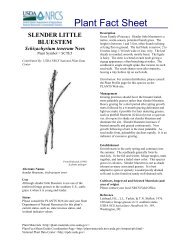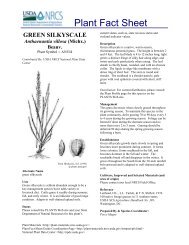Plant Fact Sheet template - USDA Plants Database - US Department ...
Plant Fact Sheet template - USDA Plants Database - US Department ...
Plant Fact Sheet template - USDA Plants Database - US Department ...
You also want an ePaper? Increase the reach of your titles
YUMPU automatically turns print PDFs into web optimized ePapers that Google loves.
establishment, and certain climatic uncertainties. All<br />
planting should be delayed until the danger of frost<br />
has past. The time of planting depends upon the<br />
latitude of the location, and may extend to August 1<br />
in lower latitudes.<br />
Buffalograss can be established from pieces of sod or<br />
sod plugs. Sod should be planted on a well prepared<br />
seedbed in 18-inch rows. Sod should be spaced from<br />
6 inches to 2 feet apart; plugs should be planted on 12<br />
to 24 inch centers depending on how quickly a<br />
complete cover is desired. When planting, dig a hole<br />
deep enough to set a plant in with the grass blades<br />
above the ground. Pack soil around the sod making<br />
sure not to cover with soil because the plant will die.<br />
Once planted, the sod should be watered for about 3<br />
weeks to ensure root establishment.<br />
Sprigs should be planted into soil that has been tilled<br />
to a depth of 4 to 6 inches. Sprigging rate should be<br />
approximately 240 bushels of sprigs per acre, planted<br />
to a depth of 1 inch or less. A planted site should be<br />
rolled to ensure good sprig-soil contact and irrigated<br />
within 3 hours after planting. Newly planted areas<br />
will also require irrigation for several weeks to<br />
maintain a moist environment for root establishment.<br />
Proper seedbed preparation for planting a home lawn<br />
is essential. Buffalograss will grow on heavy and<br />
compacted soils, but it is easier to start and maintain<br />
on good loam soils. Heavy soils may be improved by<br />
applying good quality organic matter such as peat<br />
moss, aged manure, or compost. Applying a<br />
phosphorus fertilizer stimulates seedling root growth,<br />
even on soils testing high in phosphorus. Work the<br />
soil to a depth of 4 to 6 inches. This may require<br />
plowing, discing, or tilling. The seedbed should be<br />
uniform, friable, and well-packed. Use tillage<br />
methods to control any weeds that may develop<br />
before seeding.<br />
Management<br />
Buffalograss is only recommended for low<br />
maintenance and low use turfgrass areas. Mowing<br />
height and frequency depend on grass use, amount of<br />
irrigation, and time of year. Care must be taken<br />
when mowing not to cut shorter than 2 to 3 inches to<br />
avoid other grasses from out-competing the<br />
buffalograss. Buffalograss responds well to light<br />
applications of nitrogen. Over- fertilization will<br />
promote undesirable grasses within the planted area.<br />
Buffalograss is excellent for people who want a large,<br />
attractive lawn during the summer with a minimum<br />
of work involved. Other advantages of buffalograss<br />
for lawns is that it withstands heavy usage and has<br />
good drought tolerance. However, potential lawn<br />
growers should note that buffalograss is a warmseason<br />
grass, it turns brown with fall's first freezing<br />
weather, and will not green-up until warm weather<br />
returns; it will be brown and unattractive when the<br />
neighbor’s Kentucky Bluegrass is brilliant green.<br />
During extended dry periods in the summer months,<br />
buffalograss will go brown and become dormant if no<br />
supplemental water is provided. Because of<br />
aggressive runners, buffalograss can require edging<br />
along walks, driveway, and flower beds.<br />
Pests and Potential Problems<br />
Buffalograss has no serious pests.<br />
Cultivars, Improved, and Selected Materials (and<br />
area of origin)<br />
‘Bison’, ‘Plains’, ‘Texoka’, and ‘Topgun’ (cultivars);<br />
Bismarck Ecotype (selected class release). Seeds are<br />
available at most Midwestern commercial seed<br />
sources. Sod, sod plugs, and sprigs can be obtained<br />
from sod farms.<br />
Prepared By & Species Coordinator:<br />
<strong><strong>US</strong>DA</strong> NRCS <strong>Plant</strong> Materials Program<br />
Edited: 01Feb2002 JLK; 31may06jsp<br />
For more information about this and other plants, please contact<br />
your local NRCS field office or Conservation District, and visit the<br />
PLANTS Web site or the <strong>Plant</strong> Materials<br />
Program Web site <br />
The U.S. <strong>Department</strong> of Agriculture (<strong><strong>US</strong>DA</strong>) prohibits<br />
discrimination in all its programs and activities on the basis of<br />
race, color, national origin, sex, religion, age, disability, political<br />
beliefs, sexual orientation, and marital or family status. (Not all<br />
prohibited bases apply to all programs.) Persons with disabilities<br />
who require alternative means for communication of program<br />
information (Braille, large print, audiotape, etc.) should contact<br />
<strong><strong>US</strong>DA</strong>'s TARGET Center at 202-720-2600 (voice and TDD).<br />
To file a complaint of discrimination write <strong><strong>US</strong>DA</strong>, Director, Office<br />
of Civil Rights, Room 326-W, Whitten Building, 14th and<br />
Independence Avenue, SW, Washington, DC 20250-9410 or call<br />
202-720-5964 (voice or TDD). <strong><strong>US</strong>DA</strong> is an equal opportunity<br />
provider and employer.<br />
Read about Civil Rights at the Natural Resources Convervation<br />
Service.



